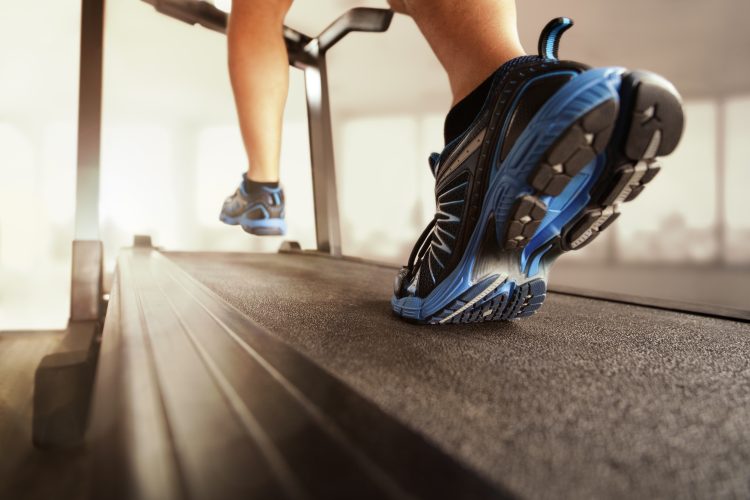Ultimately, what makes a good gym shoe depends on the type of exercise you’re doing. Identifying which activities you usually do is the most important step when it comes to finding the best gym shoes for you. There’s no point buying a pair of lightweight running trainers and taking them straight to the squat rack. Similarly, there’s no point trying to run in rigid lifting shoes.
The different types of gym shoes
If your workout involves lots of lateral movements, such as boxing or HIIT, you’ll want a shoe with good ankle support that is designed to help you stay on your toes – such as the Under Armour TriBase Reign 4 Pro or the Inov-8 F-Lite G 300.
Breathable uppers will help keep your feet cool during these intense sessions. A wide toe box, lower cushion and low heel-toe drop sets most gym shoes apart from running shoes, and help with fast direction changes.
For weight lifting, meanwhile, it’s more important that your shoe has a flat, stable base that aids squatting and power-based movements. Two good examples are the Reebok Legacy Lifter II and the Nike Metcon 8.
- Cross-training shoes
- These shoes are designed for a variety of workouts, making them versatile for gym training. They typically have a flat, stable sole and moderate cushioning.
- Best for: Functional training, high-intensity interval training (HIIT), and activities that involve lateral movements (e.g., jumping, running, and weightlifting).
- Key features: A supportive upper, a durable sole, good traction, and some flexibility to accommodate different movements.
- Running shoes
- Running shoes are generally lightweight and often feature extra cushioning to absorb impact. They vary in support depending on your pronation type (neutral, overpronation, or underpronation).
- Best for: Road running, trail running, and treadmill workouts.
- Key features: Ample cushioning, a curved sole for a natural gait, breathable materials, and stability features for overpronators or underpronators.
- Lifting shoes
- These shoes have a raised heel and a rigid sole designed to provide stability and support during heavy lifting. The elevated heel allows for better ankle mobility and deeper squats.
- Best for: Powerlifting, Olympic lifting, and strength training.
- Key features: Firm, non-compressible soles, straps for added support, and a wedge heel to improve posture during lifts.

There are plenty of good all-round gym shoes that provide support and stability during a range of workouts. If you like mixing it up from cardio to cross-training to weightlifting, an all-rounder like the Reebok Nano X2 would be ideal – it combines a stable base for heavy lifting with excellent lateral support.
You won’t get the most from a strength training session if you turn up to the gym in your running shoes. However, if you spend most of your gym time doing aerobic work, such as the treadmill or rowing machine, then a gym shoe with good running credentials like the Puma Fast-R NITRO Elite Fireglow could be the perfect fit.
Your gym shoe checklist
A good gym shoe should have several key features to ensure comfort, support, and performance during workouts. Here are some important factors to consider.
- Fit. A well-fitting shoe is crucial. It should have enough room in the toe box, a snug fit in the heel, and good overall support. Make sure to try shoes on with the socks you plan to wear while exercising.
- Arch support. Proper arch support helps in maintaining foot alignment and can prevent injuries. Look for shoes that cater to your specific arch type (high, neutral, or flat).
- Cushioning. Adequate cushioning absorbs impact during high-intensity workouts or running. Depending on your workout style, you may prefer more or less cushioning.
- Stability. Good gym shoes should provide stability, especially during lateral movements. Look for shoes that have a wider base and good traction.
- Breathability. Materials that allow your feet to breathe can prevent overheating and moisture buildup, keeping your feet comfortable during intense workouts.
- Weight. Lighter shoes can enhance performance for activities like running, while heavier shoes may provide more stability and protection for weight lifting.
- Durability. Choose shoes made from high-quality materials that can withstand the wear and tear of regular use in the gym.
- Purpose. Consider the type of workouts you’ll be doing. Cross-training shoes are versatile for various activities, while specific shoes are better for running or lifting.
- Traction. A good grip on the sole of the shoe is essential for safety, especially during dynamic movements or when using gym equipment.
- Style. While not as important as performance features, choosing a shoe you find visually appealing can boost your motivation.






